Blue Lotus Flower
The blue lotus flower, Nymphaea caerulea, historically commands a rich tapestry of cultural symbolism. Originating from the waterways of East Africa and Southeast Asia, it flourishes as an aquatic perennial. Its habitat ranges from the calm waters of ponds to the margins of lakes and rivers.
Recognized for its vibrant hue and enchanting fragrance, the flower usually blooms in the morning and retracts into the water at dusk. Your garden can host the blue lotus if you provide it with a temperate climate and adequate sunlight.
Characteristics:
Bestsellers
- Color: Vibrant blue with hints of purple at the petals' edges
- Scent: Sweet, subtle fragrance
- Bloom Time: Early summer to early autumn
- Height: Up to 18 inches above water surface
Planting Tips:
- Depth: Plant in water 1 to 18 inches deep.
- Soil: Well-fertilized loamy soil.
- Sunlight: Full to partial sun exposure is optimal.
- Spacing: Plants should have 10 to 20 inches between them.
In historical contexts, you may find the blue lotus intertwined with ancient Egyptian culture, representing the universe's birth and regeneration. It is not only esteemed for its aesthetic but also explored for its mild psychoactive properties, which were possibly employed in ritualistic contexts.
Current Usage:
- Culinary: Used to flavor certain beverages and foods.
- Herbal Remedies: Employed in aromatherapy and holistic medicine.
- Decoration: Popular in water gardens and as cut flowers in floral arrangements.
Keep in mind that while the blue lotus is admired for various applications, please consult local regulations before cultivation as its status may vary by region.
Historical Significance

The blue lotus flower holds an esteemed place in history, particularly within ancient civilizations known for their rich cultural practices and spiritual significance.
Cultural Importance
The blue lotus (Nymphaea caerulea), also known as the sacred lotus, was revered in ancient Egypt as a symbol of the universe, fertility, and rebirth. Artwork and hieroglyphics from this period often depict the blue lotus in connection with party scenes, indicating its role in celebrations and rituals.
- Egyptian tomb paintings: Commonly featured alongside figures of gods and goddesses.
- Cultural events: The flower was a staple in celebratory events, symbolizing life's beauty and divine blessing.
Ancient Usages
In the context of ancient practices, the blue lotus was used for its psychoactive properties during religious ceremonies to induce a state of euphoria and connect with the divine.
-
Medicinal applications: Employed as a traditional remedy for various ailments.
-
Spiritual rituals: Incorporated in ceremonies to enhance meditation and spiritual awareness.
-
Ritual consumption:
- Tea: Often brewed for its mild stimulant effects.
- Anointing oils: Used for ceremonial purposes and personal grooming.
Historical records from both the Egyptian and the Mayan civilizations suggest that the blue lotus was not just a decorative element but a plant with profound significance in daily life and spiritual practice.
Lao Ban Zhang
Botanical Profile

The blue lotus flower, with its striking appearance and historical significance, offers a fascinating subject for botanical study.
Species Classification
Nymphaea caerulea, commonly known as the blue lotus, is a member of the Nymphaeaceae family. It should not be confused with the "blue water lily" or "sacred lotus," which belong to distinct genera.
| Kingdom | Plantae |
|---|---|
| Division | Magnoliophyta |
| Class | Magnoliopsida |
| Order | Nymphaeales |
| Family | Nymphaeaceae |
| Genus | Nymphaea |
| Species | N. caerulea |
Habitat and Distribution
Habitat: The blue lotus thrives in freshwater environments ranging from ponds to the edges of slow-moving rivers. Optimal growth occurs in sunny locations where the water is clear and warm.
Distribution: Originally found in Egypt and other parts of East Africa, the plant's range has expanded due to human cultivation. It is now present in various locations around the world, including parts of Asia and the Mediterranean.
Cultivation Techniques
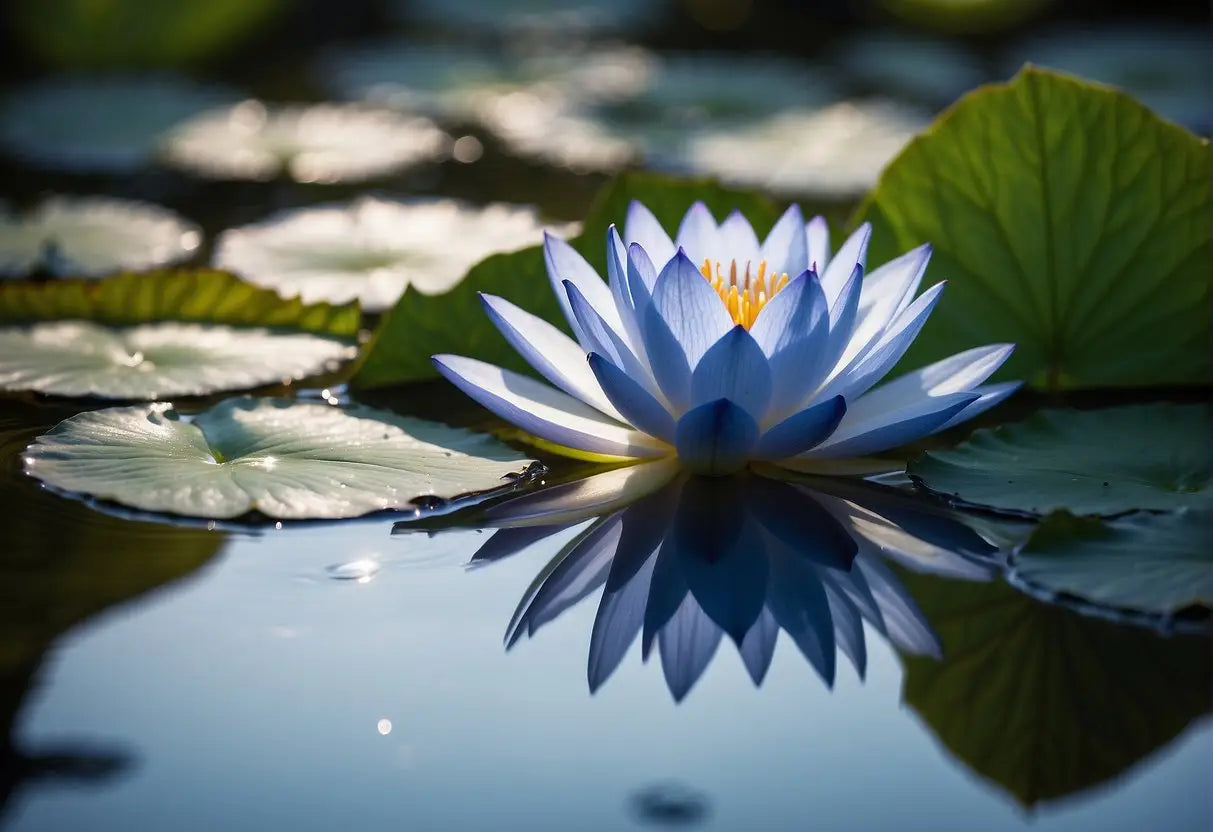
To successfully grow blue lotus flowers, you must pay close attention to their specific growth conditions and adhere to precise harvesting methods.
Growth Conditions
The blue lotus (Nymphaea caerulea) thrives in ponds and slow-moving streams with full sun exposure. It is suitable for USDA hardiness zones 10 to 12, where temperatures do not usually drop below freezing. Your water depth should range from 15 to 30 inches with a pH between 6 and 7.5. A rich loamy soil is ideal for planting. The root system, known as a rhizome, should be planted firmly in the soil or in pots submerged at the pond's bottom.
- Sunlight: Full sun
- Temperature range: Optimal between 70°F - 85°F
- Water pH: 6.0 - 7.5
- Soil: Loamy and fertile
Harvesting Methods
Harvesting blue lotus flowers requires gentle care to avoid damage to the plant and to preserve the flower's integrity for uses. Flowers should be harvested in the morning as they open up for peak freshness. Using clean, sharp shears, cut the stem at a 45-degree angle near the base, being careful not to disturb the root system underwater. Flowers are typically harvested before the hottest part of the day when they're fully open and emit a pleasant fragrance.
- Best time to harvest: Morning, as blooms open
- Tools: Sharp, sterilized shears
- Technique: Cut at 45° angle; do not disturb roots
Therapeutic Properties

The blue lotus flower, or Nymphaea caerulea, has been revered for its potential therapeutic benefits, with uses spanning from traditional applications to modern explorations.
Traditional Medicine
In traditional medicine, particularly within ancient Egyptian culture, the blue lotus was seen as a symbol of the divine and was associated with several health benefits. It was utilized to support the body's natural healing process and promote general well-being. Below are some of its traditional uses:
- Relaxation: The flower was used to soothe and calm the mind.
- Sleep Aid: It was believed to help induce sleep and alleviate insomnia.
- Libido: Sometimes used as an aphrodisiac to stimulate sexual desire.
Evidence of its traditional use was found on papyrus and wall paintings, indicating its historical significance.
Modern Research
Turning to modern studies, preliminary research suggests that compounds in the blue lotus may have various health effects. However, it's important to note that these findings are still in the early stages, and you should approach them with caution due to the limited scope of contemporary scientific inquiry.
- Antioxidant Activity: Investigations have noted the presence of antioxidants in the blue lotus, which may help combat oxidative stress.
- Anxiolytic Effects: Initial studies indicate potential stress-relieving properties.
- Analgesic Properties: There have been observations of pain-relieving effects, though more research is needed to substantiate these claims.
Research continues to uncover how the blue lotus works and its potential applications in supporting health.
Symbolism and Representation
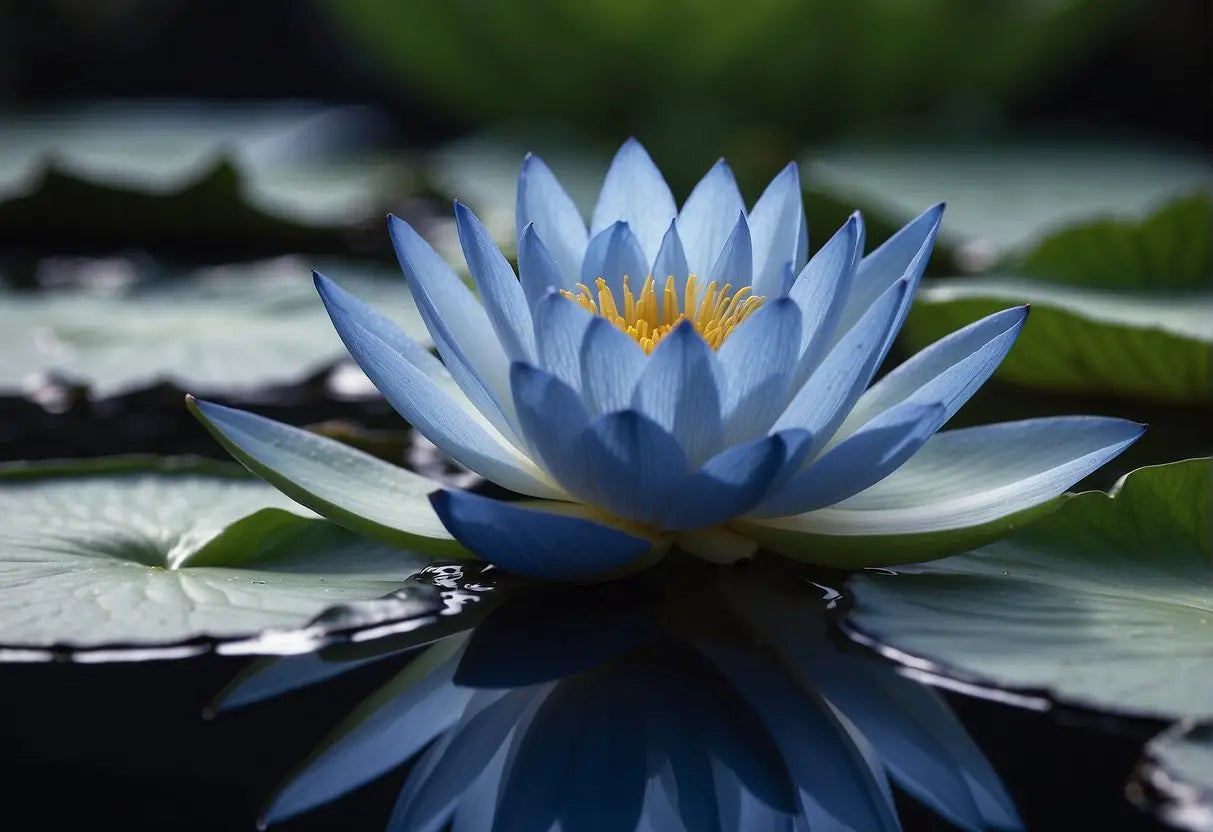
The blue lotus flower is steeped in deep symbolic meanings across various cultures, particularly in religious contexts and artistic expressions.
Religious Symbolism
In ancient Egypt, the blue lotus represented the universe's creation and was closely associated with the Sun God Ra. You can see the blue lotus in many hieroglyphics, where it is often depicted with its stems intertwined with long reeds or papyrus plants, symbolizing the unification of Upper and Lower Egypt.
In Buddhism, the flower signifies wisdom and knowledge, as it emerges clean and pure from muddy waters. Mud represents suffering, while the flourishing lotus symbolizes the journey to enlightenment.
Artistic Depictions
Art from various cultures features the blue lotus as a motif that communicates purity, beauty, and the divine. In Chinese art, it often appears in paintings and pottery, symbolizing good fortune and high status with its beauty remaining untouched despite the murky waters from which it grows.
Greek artwork has also utilized the image of the lotus, with it commonly showing up on friezes and pottery, suggesting a cross-cultural appreciation for its aesthetics and indicative symbolism of rebirth and regeneration.
Conservation Status
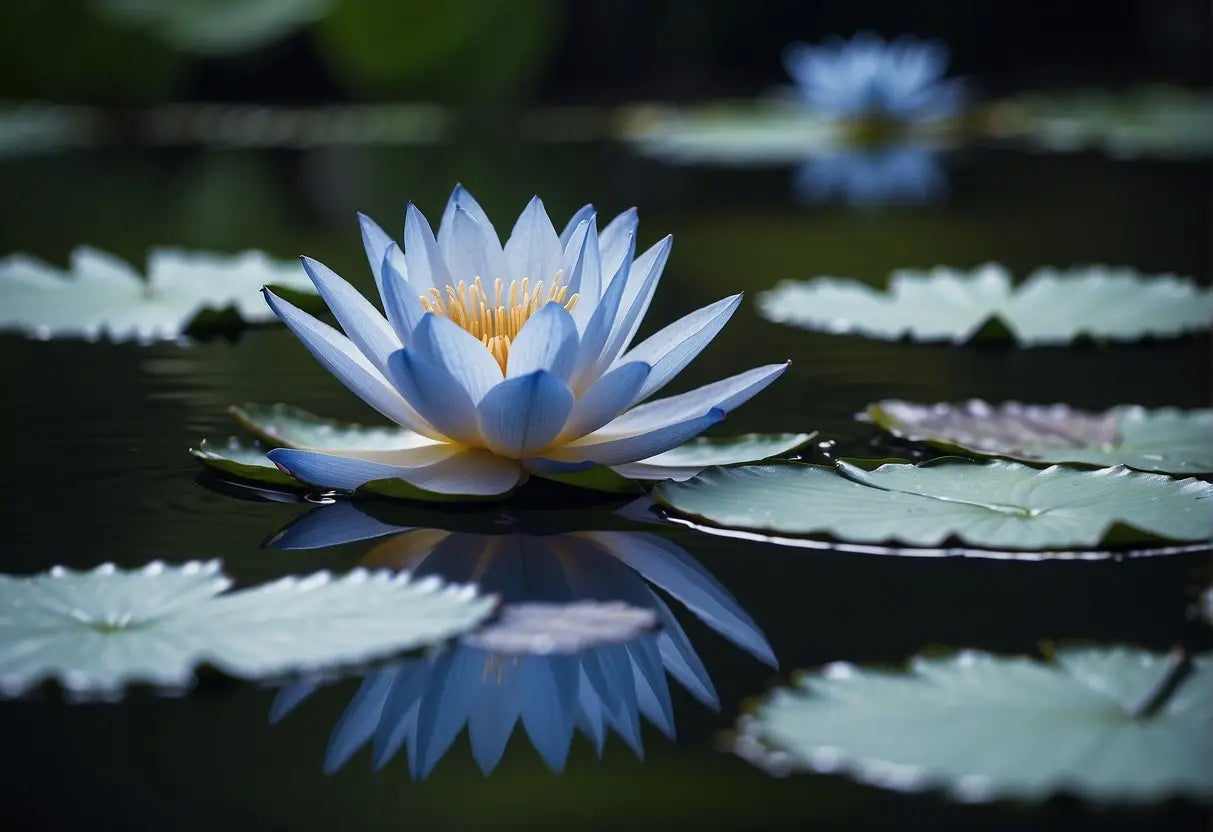
The Blue Lotus (Nymphaea caerulea), also known as the Sacred Blue Lily of the Nile, is a species that demands your attention in conservation discussions.
IUCN Status
Currently, the International Union for Conservation of Nature (IUCN) has not evaluated the conservation status of the Blue Lotus. However, it's important for you to note that absence on the IUCN Red List does not guarantee species security.
Threats
You should be aware of several threats to this species:
- Habitat loss: Conversion of wetlands for agriculture or urban development.
- Water pollution: Contaminants from industrial and agricultural runoff can damage their aquatic habitats.
Protection Efforts
Here's how protection for the Blue Lotus is typically approached:
- In situ conservation: Protection of the aquatic habitats where these plants naturally occur.
- Ex situ conservation: Cultivation in botanical gardens and aquatic nurseries to preserve genetic diversity.
Your Role
As an individual, your awareness and action matter. Through supporting wetland conservation initiatives and sustainable agricultural practices, you contribute to the preservation of the Blue Lotus ecosystem. Remember, your choices can influence the survival of these enchanting flowers.
Culinary Uses
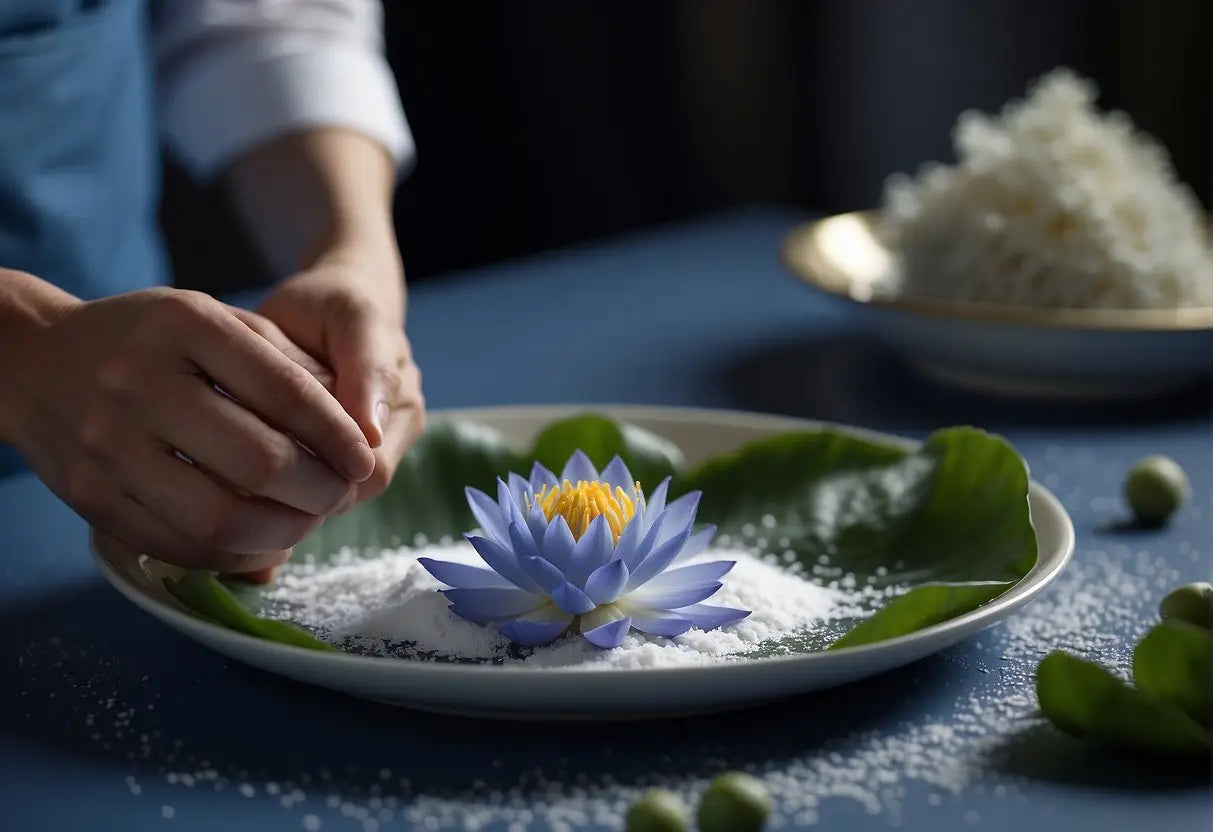
The blue lotus flower (Nymphaea caerulea), is not just an objet d'art in water gardens; it has found its way into various culinary preparations. Its use in cooking is largely due to its subtle, sweet flavor and the aesthetic appeal of its vibrant blue petals.
Tea & Beverages
- Blue Lotus Tea: You can steep dried blue lotus flowers in hot water to create an aromatic tea. This is often enjoyed for its potential relaxing properties.
- Cocktails: For a sophisticated twist, mixologists infuse blue lotus in spirits to create unique cocktails.
Appetizers & Salads
- Salad Garnish: Fresh blue lotus petals can be sprinkled over salads, adding color and a hint of flavor.
- Lotus Petal Wraps: Use fresh petals to wrap savory items, akin to stuffed grape leaves.
Desserts
- Candied Petals: Coat petals in a sugar syrup, let them crystallize, and use them to decorate cakes and pastries.
- Lotus-infused syrup: Drizzle this syrup over desserts for a floral touch.
| Form | Suggested Use | Notes |
|---|---|---|
| Fresh Petals | Garnishes, Wraps | Has a grassy taste; use sparingly |
| Dried Flowers | Teas, Infusions | More potent than fresh; imparts a deeper flavor |
| Ground Powder | Baking, Flavoring | Blend in moderate amounts for subtle flavor |
When experimenting with blue lotus in your kitchen, remember to source your flowers from reputable suppliers to ensure they are safe for consumption. Use them judiciously to not overpower your dishes.
Related Species
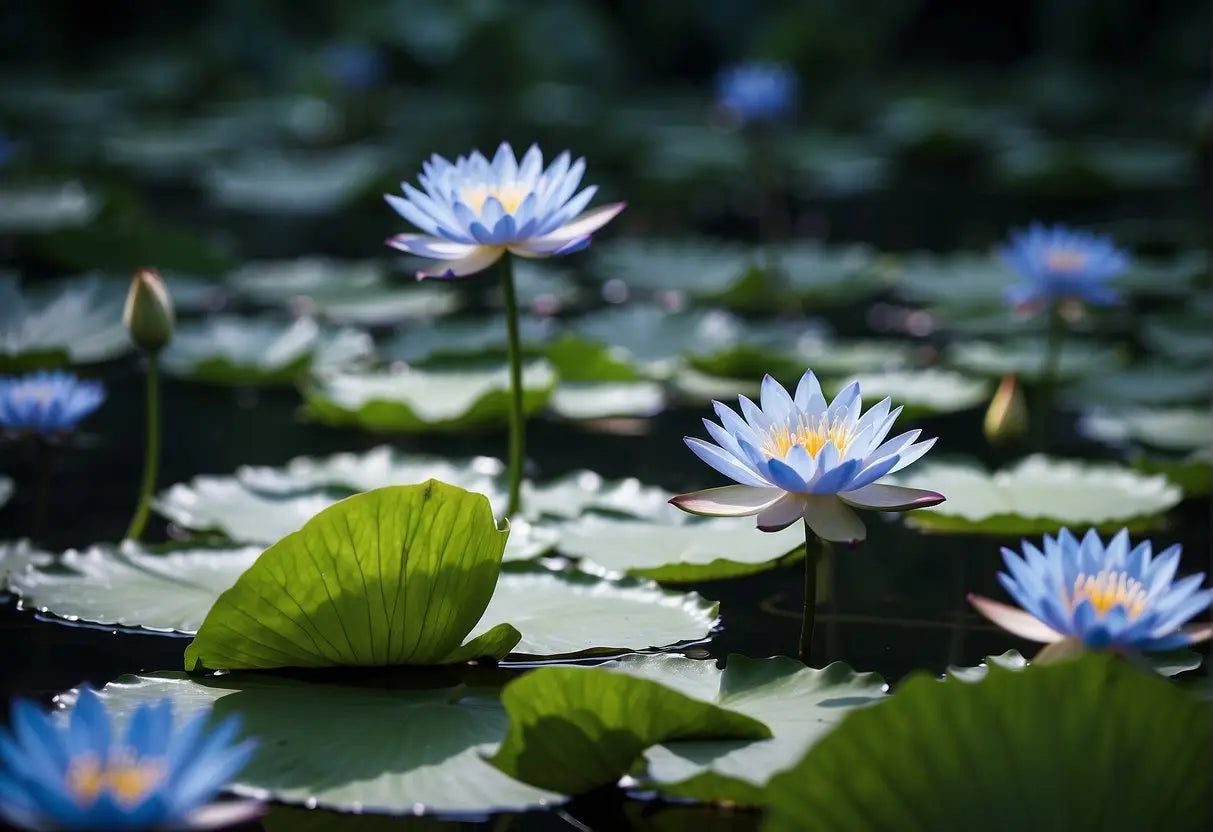
When you explore the genus Nymphaea, to which the blue lotus (Nymphaea caerulea) belongs, you'll find several relatives. Notably, the following species are closely associated with the blue lotus:
-
Nymphaea lotus: Commonly known as the white lotus or the Egyptian white water-lily. This species is indigenous to East Africa and Southeast Asia. It's frequently depicted in ancient Egyptian art alongside the blue lotus.
-
Nymphaea nouchali: Often referred to as the star lotus or red and blue water lily. Found in South Asia, it's prized for its decorative blue flowers which can vary to a deep purple.
-
Nymphaea alba: The European white water lily or white nymph, is native to Europe. This species resembles Nymphaea lotus but can be distinguished by its larger flowers and preference for cooler climates.
Here's how these species compare in terms of habitats and flower color:
| Species | Habitat | Flower Color |
|---|---|---|
| Nymphaea caerulea | Africa, Indian Subcontinent | Bright blue |
| Nymphaea lotus | East Africa, Southeast Asia | White, with a tint of pink or blue |
| Nymphaea nouchali | South Asia | Blue to purple |
| Nymphaea alba | Europe | White |
Your understanding of the blue lotus's kin aids in appreciating the diversity within Nymphaea genus. It also underscores the widespread cultural significance of these flowers across different regions.
← Older post Newer post →











